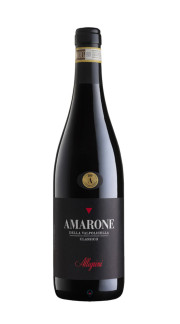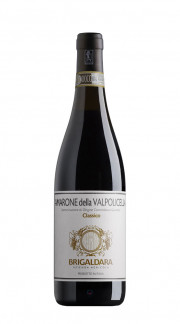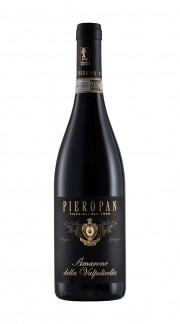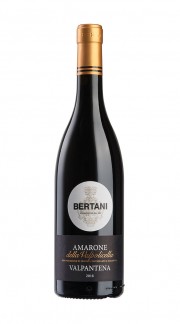Amarone wine
Great Italian enological excellence, Amarone is one of the most sumptuous and opulent red wines that you can find all over the world, a jewel that has made Valpolicella one of the most loved destinations by wine lovers. All thanks to the case, probably, but let's go in order; Amarone is mainly produced by drying the native Corvina and Rondinella grapes; this process concentrates and amplifies sugars, aromas and flavors. But be careful, Amarone is indeed a raisin wine and the sugar concentration is very high, but during fermentation all the sugar is left to transform into alcohol. The result is therefore a passito wine, very alcoholic and completely dry! Going back to history, or perhaps to legend, it is said that Amarone was born out of an oversight: that is, during the vinification of Recioto (sweet raisin wine), the winemaker on duty would have forgotten to interrupt the fermentation (he should have done so keep a little sugar in the wine and therefore make it sweet), giving life to a powerful and strong wine, but bitter, totally different from Recioto; in the area they decided to call it Amarone. There are few wines that boast such intensity and elegance and that have contributed to shaping a territory and its reference cellars!
Among the most prestigious Italian red wines we certainly include Amarone della Valpolicella . It is a wine to be opened on special occasions and to be combined with important dishes. What makes Amarone so special is its production technique, namely the appassimento . Actually, this is a pretty common method in Italy, but always used for the production of sweet wines, the ones which are defined as " passito ". Instead Amarone is not sweet, on the contrary, it is a rare case of dry wine, produced with this technique. The only other Italian wine with the same characteristics is Sforzato della Valtellina.
- Immediate availability
€ 70,00
How Amarone is born
We are in the 1930s and legend has it that Amarone was born due to a mistake in the production of Recioto . Precisely, a mistake by the cellarman of the Cantina Sociale di Valpolicella who, when bottling Recioto (sweet raisin wine, very popular at the time) forgets one of the barrels. The wine remains like this, in the forgotten barrel, for a few years. When you rediscover it, you taste the wine and not only discover that it hasn't gone bad, but it has gotten better. It had acquired body, structure, power, but the original sweetness had also given it elegance and softness. Fermentation continued slowly in the barrel, transforming the sugars into alcohol. It is no longer sweet, and for this reason it is called Amarone, i.e. very bitter, in relation to the traditional sweetness of Recioto.
The first bottle with the name Amarone on the label appeared on the market in 1936 . Since then, every year the producers of Valpolicella intentionally repeat that mistake, even if the current wine is however the result of a long experimentation over the years. Amarone has long been labeled as " Recioto Amaro " or " Recioto Amarone ". When it began to be known and appreciated on the international market, it obtained its independent denomination.
Amarone grape varieties and its vinification
Recioto, Amarone and all the Valpolicella DOC wines are produced using the same autochthonous vines, although sometimes in different proportions. The main grapes of Amarone are Corvina, Corvinone and Rondinella . The first two (together) must be present in percentages between 45% and 95%, the Rondinella between 5% and 30%; it should be added that only 40% of the total grapes of a vineyard can be selected for the production of Amarone. Small quantities of other local grapes can also be added such as Molinara (once it was mandatory), Oseleta, Dindarella, Negrara, Pelara, Spigamonti and, in even smaller quantities, some national and international vines.
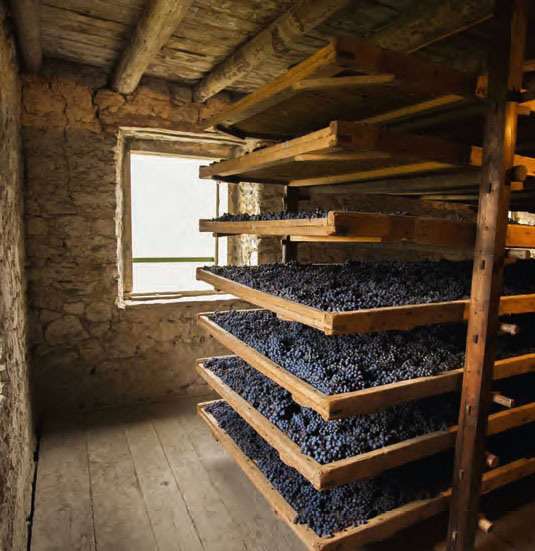 The selection of grapes for Amarone is extremely rigorous. The bunches must have the correct size or rather they must not be too large and above all they must be " loose ", a term used in botany to indicate the berries well spaced from each other. The air circulation must be uniform around the berries for optimal drying.
The selection of grapes for Amarone is extremely rigorous. The bunches must have the correct size or rather they must not be too large and above all they must be " loose ", a term used in botany to indicate the berries well spaced from each other. The air circulation must be uniform around the berries for optimal drying.
For this reason, the harvest of the Amarone grapes must be entrusted to expert personnel who know how to select the right grapes and do it quickly. Picking the wrong bunches can affect the quality of the wine. The selected grapes are then delicately placed in wooden or plastic crates and taken to the cellar. But it's not yet the time to press it. Indeed, in this phase it is very important not to crush the grapes and not to tear the berries. If the juice comes into contact with the air, unwanted fermentation could start which would jeopardize the drying process and therefore the quality of the Amarone. The crates are stacked inside large rooms called " fruit rooms", usually in the attics of farms. This is to have dry, well-ventilated and humidity-free places where the grapes can be dried perfectly. The grapes rest in the fruit cellars for about three months. At the end of the process, the dried grapes look like edible "raisins". In this period, the water inside the bunches is reduced by 30-40% and therefore the sugars are concentrated . The drying process also develops additional and complex aromas in the grapes.
Visiting the fruit cellars and smelling the air saturated with the scents of drying grapes is one of the most exciting moments during a visit to a cellar that produces Amarone.
Fermentation takes place in winter, in the coldest period of the year and can last up to 40-60 days compared to the 10-14 days needed to obtain a wine in autumn from fresh grapes. The alcohol content that develops is always very high, due to the important presence of sugars; it is now almost impossible to find an Amarone below 15°, with most hovering around 16° and some even reaching 17°. Once fermentation is complete, the wine must now move on to the maturation stage. All Valpolicella producers must comply with the strict rules of the disciplinary if they want to label their wine as Amarone della Valpolicella DOCG (Controlled and Guaranteed Denomination of Origin). Amarone must therefore mature at least two years before being bottled and placed on the market. For almost all of the cellars, the aging of Amarone takes place in oak barrels. The combinations of shapes, dimensions and origin of the wood are infinite, in fact the production disciplinary does not give specific indications.
Taste Amarone
Amarone has strong fruity scents, especially within the first 10 years of the harvest. Characteristic notes are cherry, black cherry, currant, blackberry, plum often in the form of dried fruit, in alcohol or in jam. Spicy notes such as cinnamon, licorice, nutmeg, cloves, etc. develop over time. Aging in wooden barrels (mainly oak) adds sweet, vanilla notes (especially for wines aged in 225-litre barriques) and roasted coffee, cocoa, chocolate, tobacco. Furthermore, an Amarone properly aged in the cellar for ten or more years is enriched with tertiary aromas of leather, dried mushrooms, undergrowth, balsamic hints of mint and more. The basic structure, body, intensity and persistence are really important, unique in its kind.
Amarone food pairings
Amarone is an intense and structured wine which therefore goes well with foods with intense and complex flavors which balance the power and structure of the wine. Game, savory meats, braised meats and roasts with spicy condiments, or aged cheeses. It can even become the ingredient of the typical Amarone risotto . It can also be enjoyed as a meditation wine , especially if from a very old and complex vintage. From meditation, this is how a wine is defined that can be drunk without accompanying it with food, but only for the pleasure of appreciating its refinement and elegance at the end of a meal.
Reserve Amarone
According to the production disciplinary, an Amarone can be defined as a " Riserva " after at least 4 years from the harvest, part of which is in wooden barrels. Many Valpolicella wineries produce an Amarone Riserva to differentiate their offer with the basic Amarone, produced every year, and, therefore, a "Riserva" for special vintages or with grapes from a single particularly suitable vineyard (which the French define cru ). Amarone is one of the wines with the greatest aging potential in the world. The 2015 has made a lot of talk about itself and has become almost mythological. Going back in time, the 2011, 2010, 2007, 2005, 2003, 2001, 1998 are famous. The 1997 is a historic vintage but is now almost unobtainable. Going even further there are the 1995, 1990, 1988, 1983. And it's not said that they are too old. If properly stored in the cellar, a great vintage of Amarone can continue to evolve for 30 years and more, giving you increasingly complex and refined aromas and scents.
Amarone red wine: the best for your table
Amarone is a red but dry passito, excellent above all to combine with roast meat, cheeses and more. Amarone della Valpolicella wine is a DOCG and can give something extra to your table: here you will find many bottles of the highest quality and from the best cellars.
Amarone wine: discounted price for many bottles
At Vinopuro you will be able to find a wide selection of Amarone for sale at very convenient prices: in fact, you will be able to buy bottles with truly excellent discounts . Discover the complete offer.

